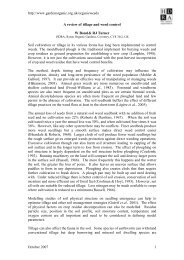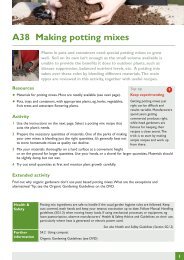A46 Installing a water butt - Garden Organic
A46 Installing a water butt - Garden Organic
A46 Installing a water butt - Garden Organic
You also want an ePaper? Increase the reach of your titles
YUMPU automatically turns print PDFs into web optimized ePapers that Google loves.
<strong>A46</strong> <strong>Installing</strong> a <strong>water</strong> <strong>butt</strong><br />
Resources<br />
•<br />
•<br />
Suitable site<br />
New or secondhand <strong>water</strong> <strong>butt</strong><br />
Activity<br />
Water <strong>butt</strong>s are simple and affordable containers that attach to a<br />
downpipe to collect rain<strong>water</strong>. This becomes a convenient reservoir<br />
during dryer spells to <strong>water</strong> plants to keep them cropping well. It<br />
also saves money and the environmental impact of using mains<br />
<strong>water</strong>. <strong>Installing</strong> a <strong>water</strong> <strong>butt</strong> is simple on most sites. This activity<br />
illustrates the range of options.<br />
1 Choose a suitable site for your <strong>water</strong> <strong>butt</strong>/s with an available<br />
downpipe, eg shed, greenhouse, building, or using special kit,<br />
polytunnel (see example suppliers below). Select a site with a firm<br />
and level surface as full <strong>water</strong> <strong>butt</strong>s can be very heavy and tip over.<br />
2 Choose your <strong>water</strong> <strong>butt</strong>.<br />
a Consider materials, eg several are made from recycled plastic.<br />
b Space available, eg 100lt is average. Slim line and larger capacity<br />
models/tanks are available.<br />
3 Choose additional features for your <strong>water</strong> <strong>butt</strong>/s.<br />
a Child-protection lock on the lid and tap.<br />
b Tap at base of <strong>water</strong> <strong>butt</strong> for filling <strong>water</strong>ing cans. It helps to raise the height of the <strong>water</strong> <strong>butt</strong> on a bought<br />
or home made stand. You can also attach a hose to the tap (you’ll get some pressure by gravity feed).<br />
c Connecting pipes to link two or more <strong>water</strong> <strong>butt</strong>s together to increase capacity.<br />
d Submersible pump for placing in <strong>water</strong> <strong>butt</strong> for powering hoses. Consult the school’s site manager to<br />
check safety details.<br />
Health &<br />
Safety<br />
Further<br />
information<br />
Two <strong>water</strong>ing cans eagerly waiting filling by a <strong>water</strong><br />
<strong>butt</strong> on stand at Greenfields Community School.<br />
Be careful when handling <strong>water</strong> <strong>butt</strong> and installing connecting pipes, ensuring adult supervision.<br />
Follow Manual Handling guidelines (SG1.3) when moving full <strong>water</strong>ing cans.<br />
B5.6 Watering plants<br />
S4.10 Using <strong>water</strong>ing systems<br />
Water <strong>butt</strong>s Direct (example supplier) www.<strong>water</strong> <strong>butt</strong>sdirect.co.uk<br />
See also Health and Safety Guidelines (Section SG1.2)<br />
LBS <strong>Garden</strong> Warehouse (example supplier) www.lbsgardenwarehouse.co.uk<br />
1
2<br />
Instructions for installing a <strong>water</strong> <strong>butt</strong><br />
1 Connect your greenhouse and shed guttering to<br />
a <strong>water</strong> <strong>butt</strong> with pipe extensions.<br />
2 Connect a <strong>water</strong> <strong>butt</strong> to your downpipe using<br />
the connection kit supplied by manufacturer.<br />
This usually involves drilling a small hole on<br />
the side of the <strong>water</strong> <strong>butt</strong> to connect the inlet<br />
hose, and then cutting a small slice from your<br />
downpipe to fit the divertor.<br />
Important note: some schools have large or<br />
cast iron downpipes not suitable for connecting<br />
<strong>water</strong> <strong>butt</strong>s. Seek advice from manufacturer and<br />
school site manager.<br />
3 Cover <strong>water</strong> <strong>butt</strong>s with a well fitting lids.<br />
This helps keep <strong>water</strong> clean and reduces the<br />
number of mosquitoes in summer. Also, clean<br />
your <strong>water</strong> <strong>butt</strong> regularly (at least twice yearly)<br />
for good garden hygiene, including gutters and<br />
downpipes. Water shouldn’t become stagnant or<br />
smell if <strong>water</strong> <strong>butt</strong> used and cleaned often.<br />
4 Use the saved <strong>water</strong> by dipping a <strong>water</strong>ing can<br />
into open <strong>water</strong> <strong>butt</strong> or draining from a tap<br />
near the base.








